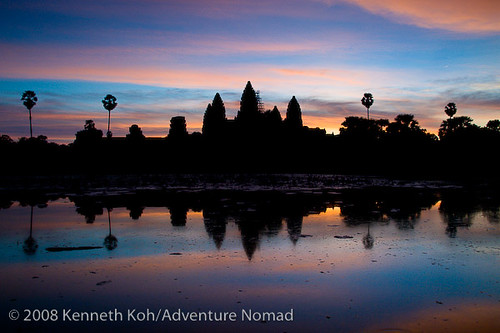 Stone Face at The Bayon. Nikon D300, 18-200mm, 1/640 f/13, ISO 800.
Stone Face at The Bayon. Nikon D300, 18-200mm, 1/640 f/13, ISO 800.No trip to Cambodia is complete with visiting the temples of Angkor in Siem Reap. There, the ruins of a lost civilization continue to wow the modern visitor with its grandeur, architecture and intricate carvings. There’s a lot to see, but even if you are short on time, you should at least spend a day visiting the big three temples in Angkor.
 Sunrise at Angkor Wat. Nikon D300, 18-200mm, 1/60 f/8, ISO 200.
Sunrise at Angkor Wat. Nikon D300, 18-200mm, 1/60 f/8, ISO 200.Angkor Wat
Angkor Wat is the biggest religious structure in the world. The outer walls are over 2 miles long, the moat is as wide as 2 football fields, and the temple itself is as high as Notre Dame Cathedral. Angkor Wat is a representation of a symbolic Hindu universe. The temple itself symbolizes the five peaks of Mount Meru, the walls are distant mountains, and the vast moat are the oceans.
Wake up well before dawn to catch sunrise at Angkor Wat. You’ll need to prearrange a pickup with a Tuk Tuk driver. The complex opens at 5am, and you can buy a one-day pass (USD$20) on the way in.
Enter Angkor Wat from the west entrance and make your way in to capture sunrise. If you intend to photograph it, you’ll need a tripod. Once the sun comes up, the show is over, make your way out of Angkor Wat and head over to the South Gate of Angkor Thom and the Bayon.
 Sanctuary at the Bayon. Nikon D300, 10.5mm, 1/250 f/5.6, ISO 800.
Sanctuary at the Bayon. Nikon D300, 10.5mm, 1/250 f/5.6, ISO 800.The Bayon
The Bayon is famous for its massive stone faces carved into the many towers of the temple. It is now thought that the faces are an amalgamate of King Jayavarman VII and Buddha. If you are here early enough, you should have the place pretty much to yourself but don’t stay too long, you’ll want to make your way over to the most photogenic temple before the crowds arrive.
 A Monk at the temple of Ta Prohm. Nikon D300, 10.5mm, 1/250 f/5, ISO 800.
A Monk at the temple of Ta Prohm. Nikon D300, 10.5mm, 1/250 f/5, ISO 800.Ta Prohm
While some temples are so fully restored that they look as if its inhabitants had just moved out, Ta Prohm has been left in almost the same state as it was when it was first discovered. The reason for this is that the restoration workers wanted to find a balance between fully restoring a site and leaving it in its found state. At Ta Prohm, they have even left huge trees in place where the massive roots are slowly pushing the building blocks apart.
 Exiting the Gates of Angkor Thom on a Motorbike. Nikon D300, 10.5mm, 1/250, f/22, ISO 200.
Exiting the Gates of Angkor Thom on a Motorbike. Nikon D300, 10.5mm, 1/250, f/22, ISO 200.Ta Prohm is my favorite of the temples at Angkor. Hopefully, you’ll be able to get some good shots before the hordes of tourists arrive. Once they do, its time to head back to the Bayon where you can get some lunch, then spend the afternoon exploring the temple of Angkor Wat itself. If you still have the energy, head up to the hill temple of Phnom Bakheng to see the warm light of late afternoon on Angkor Wat. Stay for sunset, and then head back to town for dinner.

No comments:
Post a Comment